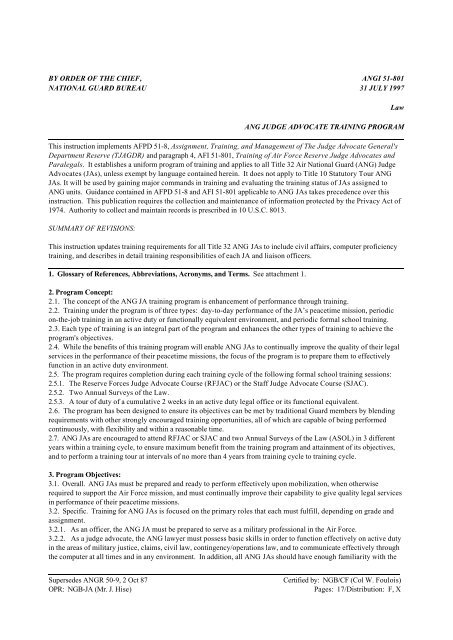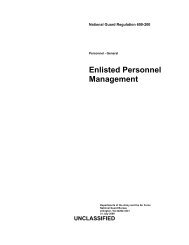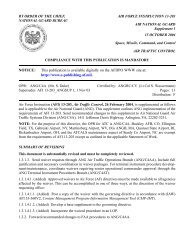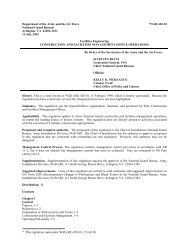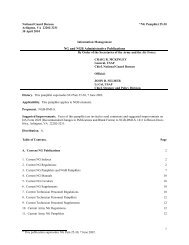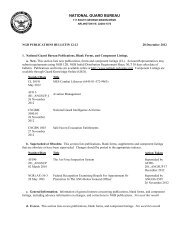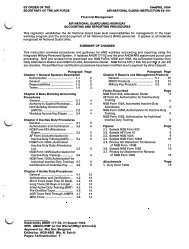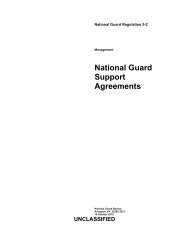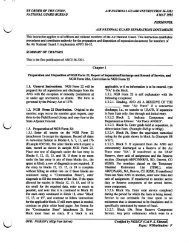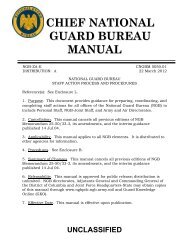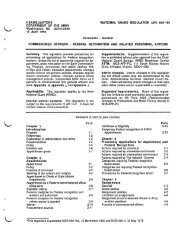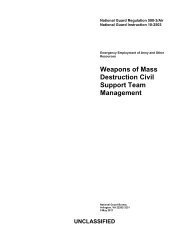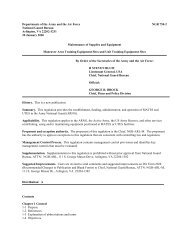ANGI 51-801 - NGB Publications and Forms Library
ANGI 51-801 - NGB Publications and Forms Library
ANGI 51-801 - NGB Publications and Forms Library
Create successful ePaper yourself
Turn your PDF publications into a flip-book with our unique Google optimized e-Paper software.
BY ORDER OF THE CHIEF, <strong>ANGI</strong> <strong>51</strong>-<strong>801</strong>NATIONAL GUARD BUREAU 31 JULY 1997LawANG JUDGE ADVOCATE TRAINING PROGRAMThis instruction implements AFPD <strong>51</strong>-8, Assignment, Training, <strong>and</strong> Management of The Judge Advocate General'sDepartment Reserve (TJAGDR) <strong>and</strong> paragraph 4, AFI <strong>51</strong>-<strong>801</strong>, Training of Air Force Reserve Judge Advocates <strong>and</strong>Paralegals. It establishes a uniform program of training <strong>and</strong> applies to all Title 32 Air National Guard (ANG) JudgeAdvocates (JAs), unless exempt by language contained herein. It does not apply to Title 10 Statutory Tour ANGJAs. It will be used by gaining major comm<strong>and</strong>s in training <strong>and</strong> evaluating the training status of JAs assigned toANG units. Guidance contained in AFPD <strong>51</strong>-8 <strong>and</strong> AFI <strong>51</strong>-<strong>801</strong> applicable to ANG JAs takes precedence over thisinstruction. This publication requires the collection <strong>and</strong> maintenance of information protected by the Privacy Act of1974. Authority to collect <strong>and</strong> maintain records is prescribed in 10 U.S.C. <strong>801</strong>3.SUMMARY OF REVISIONS:This instruction updates training requirements for all Title 32 ANG JAs to include civil affairs, computer proficiencytraining, <strong>and</strong> describes in detail training responsibilities of each JA <strong>and</strong> liaison officers.1. Glossary of References, Abbreviations, Acronyms, <strong>and</strong> Terms. See attachment 1.2. Program Concept:2.1. The concept of the ANG JA training program is enhancement of performance through training.2.2. Training under the program is of three types: day-to-day performance of the JA’s peacetime mission, periodicon-the-job training in an active duty or functionally equivalent environment, <strong>and</strong> periodic formal school training.2.3. Each type of training is an integral part of the program <strong>and</strong> enhances the other types of training to achieve theprogram's objectives.2.4. While the benefits of this training program will enable ANG JAs to continually improve the quality of their legalservices in the performance of their peacetime missions, the focus of the program is to prepare them to effectivelyfunction in an active duty environment.2.5. The program requires completion during each training cycle of the following formal school training sessions:2.5.1. The Reserve Forces Judge Advocate Course (RFJAC) or the Staff Judge Advocate Course (SJAC).2.5.2. Two Annual Surveys of the Law.2.5.3. A tour of duty of a cumulative 2 weeks in an active duty legal office or its functional equivalent.2.6. The program has been designed to ensure its objectives can be met by traditional Guard members by blendingrequirements with other strongly encouraged training opportunities, all of which are capable of being performedcontinuously, with flexibility <strong>and</strong> within a reasonable time.2.7. ANG JAs are encouraged to attend RFJAC or SJAC <strong>and</strong> two Annual Surveys of the Law (ASOL) in 3 differentyears within a training cycle, to ensure maximum benefit from the training program <strong>and</strong> attainment of its objectives,<strong>and</strong> to perform a training tour at intervals of no more than 4 years from training cycle to training cycle.3. Program Objectives:3.1. Overall. ANG JAs must be prepared <strong>and</strong> ready to perform effectively upon mobilization, when otherwiserequired to support the Air Force mission, <strong>and</strong> must continually improve their capability to give quality legal servicesin performance of their peacetime missions.3.2. Specific. Training for ANG JAs is focused on the primary roles that each must fulfill, depending on grade <strong>and</strong>assignment.3.2.1. As an officer, the ANG JA must be prepared to serve as a military professional in the Air Force.3.2.2. As a judge advocate, the ANG lawyer must possess basic skills in order to function effectively on active dutyin the areas of military justice, claims, civil law, contingency/operations law, <strong>and</strong> to communicate effectively throughthe computer at all times <strong>and</strong> in any environment. In addition, all ANG JAs should have enough familiarity with theSupersedes ANGR 50-9, 2 Oct 87OPR: <strong>NGB</strong>-JA (Mr. J. Hise)Certified by: <strong>NGB</strong>/CF (Col W. Foulois)Pages: 17/Distribution: F, X
2 <strong>ANGI</strong> <strong>51</strong>-<strong>801</strong>, 31 July 1997many subject matters faced by active duty JAs to recognize problems <strong>and</strong> underst<strong>and</strong> where <strong>and</strong> how to findanswers. Although many ANG JAs have civilian or former military practice specialties that are exceptionally valuableto the Air Force, their achievement of competency in many subject areas of military law is essential.3.2.3. As a manager, a senior ANG JA must be ready to function effectively as an active duty SJA to a comm<strong>and</strong>er<strong>and</strong> oversee the administration of an Air Force legal office.3.2.4. State headquarters JAs (other than those JAs assigned to support <strong>NGB</strong>-JA) must be qualified to functioneffectively in the Air Force Civil Affairs mission.4. Training Responsibilities:4.1. Each ANG JA is individually responsible for developing <strong>and</strong> maintaining the skills <strong>and</strong> experience necessary tocarry out the peacetime mission of the JA <strong>and</strong> to act immediately <strong>and</strong> effectively in the active force if mobilized, orwhen otherwise required to support the Air Force mission.4.2. The ANG Assistant to The Judge Advocate General (TJAG) is responsible for:4.2.1. The overall coordination of the ANG JA training program.4.2.2. The supervision of ANG Assistants to major comm<strong>and</strong> (MAJCOM) SJAs in their activities related to thisprogram.4.2.3. The education <strong>and</strong> overall compliance of ANG JAs to the provisions of this publication (<strong>ANGI</strong> <strong>51</strong>-<strong>801</strong>).4.3. ANG Assistants to MAJCOM SJAs are responsible for ensuring accomplishment of the training objectives ofthis publication by:4.3.1. Assisting the SJAs of the major comm<strong>and</strong>s to which they are assigned in implementing this program.4.3.2. Monitoring training tours <strong>and</strong> other training activities of ANG JAs assigned to their respective gainingMAJCOMs.4.3.3. Necessary coordination with Air Force representatives to carry out the training objectives of this instruction.4.4. ANG Liaisons are responsible for coordinating, advising, <strong>and</strong> assisting in implementing this program atintermediate gaining comm<strong>and</strong> levels as directed by the ANG Assistant to the SJA of the MAJCOM to which or towhom the intermediate comm<strong>and</strong> is assigned. If there is no ANG Liaison designated at the Numbered Air Force(NAF) or comm<strong>and</strong> level, the duties of the ANG Liaison will be performed by the ANG Assistant to the appropriateMAJCOM SJA.4.5. State Headquarters Liaisons are responsible for coordinating, advising, <strong>and</strong> assisting in implementing thisprogram under the supervision of the ANG Assistant to TJAG, for State Headquarters ANG JAs, except thoseassigned to support <strong>NGB</strong>-JA.4.6. The SJA of each gaining MAJCOM is responsible for assuring that this training program is implemented <strong>and</strong>that the training requirements are met by all ANG JAs assigned to units gained by the SJA's MAJCOM.4.7. The SJA of an active duty base or other supervising JA to whom an ANG JA reports for a training tour isresponsible for assisting the ANG JA to carry out the training aims of this instruction. The SJA should see that thetraining goals remain the top priority for the duration of the tour, absent extraordinary circumstances. (See alsoparagraph 5.5.3., below).5. Program Requirements. ANG JAs are encouraged, whenever practicable, to complete additional training thanthat required, consistent with the program's objectives.5.1. The training requirements contained in this instruction do not apply to the Title 32 AGR JAs. Additional training<strong>and</strong> tours of these JAs are within the purview of the State adjutant general.5.1.1. ANG JAs will be trained through all three types of training under this program to ensure they possess basicminimum skills to function effectively in their peacetime missions <strong>and</strong> on active duty consistent with their respectivewartime missions as determined by higher authorities. The training guide in attachment 2 (for all ANG JAs, exceptTitle 32 AGR JAs) <strong>and</strong> the activities in attachment 3 (for senior ANG JAs) have been designed as benchmarks ofskills which ANG JAs should strive to obtain during a training cycle. If the skills in attachments 2 <strong>and</strong> 3 are notobtained during a training cycle, ANG JAs should try to obtain them in the next training cycle.5.2. RFJAC/SJAC:5.2.1. With the effective date of this instruction (<strong>ANGI</strong> <strong>51</strong>-<strong>801</strong>), senior ANG JAs or the senior JA in an ANG legaloffice are urged to complete the SJAC (if not already completed) in their next training cycle.5.2.2. ANG JAs are strongly encouraged to complete the SJAC during the training cycle when they become seniorANG JAs. A senior JA assigned to an ANG legal office after the effective date of this instruction, <strong>and</strong> havingcompleted RFJAC or a 2-week training tour during this cycle, is urged to complete the SJAC in the next training cycle.
<strong>ANGI</strong> <strong>51</strong>-<strong>801</strong>, 31 July 1997 35.3. ASOL. ANG JAs must attend <strong>and</strong> complete the ASOL every other year <strong>and</strong> at least two ASOLs in each trainingcycle whether or not the RFJAC/SJAC or training tour requirements are satisfied in the year the ASOL is attended.ANG JAs are encouraged to have a different JA from the same ANG legal office attend the ASOL each year so that atleast one JA from the same ANG legal office attends every year.5.4. Civil Affairs:5.4.1. Unless already completed or exempt, ANG JAs assigned as State Headquarters JAs on the effective date ofthis instruction must complete the Civil Affairs Officers Advanced Course by correspondence (Phase I), within 9months of the effective date of this instruction.5.4.2. Unless already completed or exempt, ANG JAs assigned as State Headquarters JAs after the effective date ofthis instruction must complete the Civil Affairs Officers Advanced Course by correspondence (Phase I), within 9months of such assignment.5.4.3. All ANG JAs not assigned as State Headquarters JAs are encouraged to complete the Civil Affairs OfficersAdvanced Course by correspondence (Phase I), or otherwise.5.4.4. Unless the Civil Affairs Officers Advanced Course has first been completed, no ANG JA will be permitted toperform a Civil Affairs tour without the consent of the ANG Assistant to TJAG. (See paragraph 5.5.6.7 below).5.5. Training Tours:5.5.1. Duration. Training tours must be at least 1 week (5 consecutive <strong>and</strong> full-business days excluding travel days)in duration, <strong>and</strong> the 2-week tour requirement may be performed in separate or consecutive weeks during a trainingcycle.5.5.2. Type. Tours may be performed in active duty Air Force legal offices or their functional equivalents to include<strong>NGB</strong>, CONUS, or OCONUS deployments with the ANG JAs assigned unit or with another active or air reservecomponent unit, <strong>NGB</strong>-sponsored OCONUS programs, Civil Affairs tours, TJAG (USAF)-sponsored programs such asthe International Military Education & Training (IMET) program, or as otherwise determined from time to time by theANG Assistant to TJAG. Given the wartime mission of State Headquarters JAs, they will maximize the trainingobjectives of this instruction by performing Civil Affairs tours, if available.5.5.2.1. All ANG JAs (except State Headquarters JAs) must be prepared to function as active duty JAs at base level,either as SJAs or as JAs. State Headquarters JAs must be prepared to function as active duty JAs in the Civil Affairsarena in support of Air Force operations. The flexibility afforded in the type of training tours performed during anANG JA’s career should be exercised to gain the broadest range of practical experience consistent with the judgeadvocate's wartime mission <strong>and</strong> peacetime duties.5.5.3. Focus. The primary focus of all types of training tours should be to supplement the training the JA receivesthrough performance of the peacetime mission <strong>and</strong> formal school training to do what the ANG JA may be called on todo on active duty. Accordingly, definite objectives should be set in advance of the tour <strong>and</strong> tours should not bescheduled or performed to merely provide the legal office where the tour is performed with an additional attorney toh<strong>and</strong>le an existing workload.5.5.4. Scheduling:5.5.4.1. ANG JAs who are neither State headquarters JAs nor ANG JAs serving Title 32 AGR tours. All trainingtours, regardless of type or location, will be scheduled by the ANG JA with the coordination <strong>and</strong> prior approval ofthe ANG Liaison to the gaining NAF of the ANG JA who will perform the tour. In the ANG Liaison’s absence, theANG JA will coordinate <strong>and</strong> obtain prior approval for the tour from the MAJCOM Assistant to the gaining MAJCOMof the ANG JA who will perform the tour. In scheduling the training tour, the ANG Liaison or the ANG MAJCOMAssistant should assess the workloads <strong>and</strong> levels of expertise in each of the functional training areas in attachments2 <strong>and</strong>/or 2 <strong>and</strong> 3, as applicable, at the active duty or equivalent legal office where the tour will be performed, to decidethe office is well-suited to meet the particular training needs <strong>and</strong> objectives of the ANG JA.5.5.4.2. State headquarters JAs. All training tours will be scheduled by the ANG JA with the coordination <strong>and</strong> priorapproval of the appropriate State Headquarters Liaison (east or west) depending on whether the State Headquartersor military law office of the ANG JA is east or west of the Mississippi River.5.5.4.3. All training tours, depending on their type, must also have the prior approval of the supervising active dutySJA, <strong>NGB</strong> (for <strong>NGB</strong> sponsored tours) or the ANG Civil Affairs Coordinator (for Civil Affairs tours).5.5.5. Legal Assistance. Legal assistance, while recognized as one essential service within a base-level legal office,should be minimized in favor of training in other functional office areas. Accordingly, ANG JAs may perform legalassistance during training tours as long as it is not proportionately greater than legal assistance performed by theactive duty personnel regularly assigned to that office.5.5.6. Content:
4 <strong>ANGI</strong> <strong>51</strong>-<strong>801</strong>, 31 July 19975.5.6.1. Base-level tours. Tours at active duty bases should be scheduled to obtain primary exposure in one to twofunctional areas in a given week. Performing miscellaneous tasks in several functional areas or being assigned workas an extra judge advocate in the office does not maximize the objectives of the training program, i.e., cohesivetraining in a functional area to increase proficiency in that area. Accordingly, with advance coordination <strong>and</strong>approval of the base SJA <strong>and</strong> the Chief of that office's functional area (e.g., Military Justice, Claims, Civil Law,Contingency/Operations Law), the ANG JA should work under the supervision of the chief of a functional area tobecome familiar with tasks by performing, observing, or reviewing those tasks. The Training Guide in attachment 2identifies tasks in specified functional areas typically encountered by active duty, base-level, legal offices.5.5.6.1.1. A corollary to concentrating on functional areas during a training tour is to perform the tour at a base thathas a sufficient workload to maximize the opportunities for obtaining proficiency in those functional areas.Accordingly, after the ANG JA identifies the areas in which to receive training, the ANG JA <strong>and</strong> ANG Liaison should,to the maximum extent possible, match the particular training needs of the ANG JA to a base within the same NAF, ifpossible, that can provide sufficient training opportunities, even if that base is not the nearest to the ANG JA’s homeinstallation.5.5.6.2. NAF, MAJCOM, OTJAG Tours. Tours at a NAF, MAJCOM or OTJAG should normally only be performedby senior ANG JAs to obtain experience <strong>and</strong> exposure to the areas identified in attachment 3. Given the broad rangeof skills required of senior ANG JAs on active duty, these tours should not be scheduled in any one office for morethan 1 week <strong>and</strong> must have the prior approval of the ANG Liaison, <strong>and</strong> the NAF SJA, MAJCOM SJA, or TJAG, as thecase may be.5.5.6.3. CONUS or OCONUS deployments with active or air reserve component units. Generally, these tours shouldonly satisfy the training tour requirement if the deployment scenario permits the ANG JA to function in anenvironment reasonably equivalent to active duty as determined by the ANG Assistant to TJAG or delegate. Whennot functioning under the supervision of an active duty JA during the deployment, the ANG JA’s performance maysatisfy the training tour requirement if the deployment comm<strong>and</strong>er evaluates it as improving the JA’s effectiveness asa JA <strong>and</strong> an Air Force officer.5.5.6.4. IMET Tours. These tours must also have prior approval of TJAG, USAF <strong>and</strong> the ANG Assistant to TJAG.5.5.6.5. <strong>NGB</strong> Tours. Tours at <strong>NGB</strong> provide ANG JAs experience in h<strong>and</strong>ling issues <strong>and</strong> working problems at highgovernment levels, especially in areas requiring specialized legal expertise. State Headquarters Liaisons, ANGLiaisons <strong>and</strong> MAJCOM Assistants, as the case may be, should coordinate in writing with <strong>NGB</strong> to ensure a match ofexpertise of the ANG JA <strong>and</strong> that required for the specific task to be performed. Tours must be approved in advanceby the Chief Counsel, <strong>NGB</strong>.5.5.6.6. <strong>NGB</strong>-sponsored OCONUS Tours. These tours must also have prior approval of the Chief Counsel, <strong>NGB</strong>.5.5.6.7. Civil Affairs Tours. These tours must also have prior approval of the ANG Civil Affairs Coordinator <strong>and</strong>ANG Assistant to TJAG. (See paragraph 5.4.4. above).5.5.7. End-of-tour review <strong>and</strong> reporting:5.5.7.1. At the end of each training tour the ANG JA, the chief of the functional area where the work was performed,<strong>and</strong> SJA (to the extent applicable to the type of tour performed) will meet to review <strong>and</strong> critique the work performedby the ANG JA.5.5.7.2. At the end of each training tour the supervising SJA, or in absence thereof, the deployment comm<strong>and</strong>er atthe site of the tour, will prepare a letter of evaluation (LOE) of the ANG JA’s performance in satisfaction of thetraining objectives <strong>and</strong> send it to the ANG JA’s OPR rater, wing/group comm<strong>and</strong>er or equivalent, <strong>and</strong> ANG Liaison,or State Headquarters Liaison, as appropriate.5.5.7.3. ANG JAs will prepare an end-of-tour report summarizing their activities <strong>and</strong> send it to the ANG Liaison orState Headquarters Liaison, as appropriate, within 30 days of completion of the tour. There is no prescribed format orlength for the end-of-tour report but it must include the names <strong>and</strong> ranks of the chiefs of the functional areas ortraining supervisors <strong>and</strong> SJA where work was performed. In their absence, the deployment comm<strong>and</strong>er will preparethe report, giving the location <strong>and</strong> duration of the tour, a statement of the training objectives in scheduling the tour, abrief description of the activities performed in the functional areas using attachments 2 <strong>and</strong> 3 for guidance, <strong>and</strong> anyunusual work activities, problems, or issues encountered. The after action report required to be prepared by ANGJAs deploying OCONUS with active or air reserve component units <strong>and</strong> sent to <strong>NGB</strong> (attachment 6) may also be sentto the ANG Liaison or State Headquarters Liaison, as the case may be, in lieu of a separate, end-of-tour report. FLITEis the preferred method to transmit these reports.5.5.7.4. The ANG Assistant to TJAG may deny credit under this instruction for training tours which do not meet therequirements of this instruction.
<strong>ANGI</strong> <strong>51</strong>-<strong>801</strong>, 31 July 1997 55.6. Training Folders. Each ANG JA will maintain a training folder at the unit of assignment which is st<strong>and</strong>ard USAFissue; in six-sections <strong>and</strong> approximately 9-1/2" x 11-3/4" in size. Include <strong>and</strong> retain materials as set forth in attachment4.5.7. Reporting. There are two reporting requirements of ANG judge advocates under this instruction.5.7.1. End-of-tour reports as provided in paragraph 5.5.7. above.5.7.2. Continual updating of their ANG JA Roster. All ANG JAs are required to log their completed roster into FLITE<strong>and</strong> to update it in FLITE no later than 30 days after changes to any existing information on the roster or transmittalof a changed roster format. Changes in the roster format will be transmitted through FLITE. Since the updated rosteris the primary means to obtain current information about <strong>and</strong> track the career progress of ANG JAs to monitortraining for future assignments, contingencies, <strong>and</strong> other contacts, ANG JAs are urged to update their rosters inFLITE as soon as possible.6. Other Training. ANG JAs are strongly encouraged to:6.1. Complete the appropriate level of professional military education (PME) in residence, by seminar or bycorrespondence.6.2. Become proficient in using computers <strong>and</strong> be able to send <strong>and</strong> receive messages in FLITE, JAGMAIL or itsfunctional equivalent, <strong>and</strong> be able to use the REFLEX program.6.3. Increase their professional expertise as Air Force officers <strong>and</strong> JAs through completion of specialty law courses,attendance at MAJCOM, NAF, reserve component <strong>and</strong> <strong>NGB</strong> conferences, workshops <strong>and</strong> seminars, service schoolleadership, management, <strong>and</strong> quality courses, <strong>and</strong> participation in selection or promotion boards wheneverpracticable.7. Measurement of Performance:7.1. Performance of the day-to-day mission. The ANG Assistant to TJAG or delegate may measure performance ofANG JAs day-to-day mission through their OPRs, ORIs <strong>and</strong> QAFAs.7.2. Formal School Requirements. The ANG Assistant to TJAG or delegate may measure performance ofRFJAC/SJAC <strong>and</strong> the ASOL requirements through an individual ANG JA’s roster on FLITE.7.3. Training Tour. The ANG Assistant to TJAG or delegate may measure performance of the training tourrequirement through an individual ANG JA’s roster on FLITE <strong>and</strong> transmittal of the ANG JA’s end-of-tour report <strong>and</strong>LOE after a tour is completed.8. Extensions of Training Requirements. The ANG Assistant to TJAG is authorized to grant requests forextensions of training requirements when requests are processed through the appropriate State HeadquartersLiaisons or ANG Liaisons <strong>and</strong> then to the MAJCOM Assistants, if appropriate.9. Failure to Meet Training Requirements. Any ANG JA who fails to comply with the requirements of AFPD <strong>51</strong>-8,Assignment, Training, <strong>and</strong> Management of Members of the Judge Advocate General’s Department Reserve, AFI <strong>51</strong>-<strong>801</strong>, Training of Air Force Reserve Judge Advocates <strong>and</strong> Paralegals, or <strong>ANGI</strong> <strong>51</strong>-<strong>801</strong>, (this instruction) is subject toremoval from TJAGDR.10. Changes or Supplements. The ANG Assistant to TJAG is authorized to issue changes or supplements to thisinstruction, after review by <strong>NGB</strong>.OFFICIALDONALD W. SHEPPERDMajor General, USAFDirector, Air National GuardDEBORAH GILMOREChiefAdministrative Services6 Attachments1. References, Abbreviations, Acronyms, <strong>and</strong> Terms2. Training Guide3. Senior ANG JA Activities
6 <strong>ANGI</strong> <strong>51</strong>-<strong>801</strong>, 31 July 19974. Organization of Training Folder5. Personal Data Sheet Summary6. JA Support for ANG Units Deploying OverseasAttachment 1GLOSSARY OF REFERENCES, ABBREVIATIONS, ACRONYMS, AND TERMSReferences:5 USC 552(a), The Privacy Act10 USC <strong>801</strong>3, Secretary of the Air Force18 USC 1385, Posse Comitatus ActTitle 4, Code of Federal Regulations, Bid Protest Regulations, current editionManual for Courts-Martial, 1995 EditionDepartment of Defense Directive 5500-7-R, Joint Ethics RegulationUnited States Air Force War <strong>and</strong> Mobilization Plan, Volume 1, Annexes P <strong>and</strong> RAFI 10-401, Operation Plan <strong>and</strong> Concept Plan Development <strong>and</strong> ImplementationAFI 34-501, Disposition of Personal PropertyAFPD 36-27, Social ActionsAFI 36-2701, Social Actions ProgramsAFI 36-2909, Professional <strong>and</strong> Unprofessional RelationshipsAFI 36-3209, Administrative Separation of Reserve Component MembersAFPD <strong>51</strong>-8, Assignment, Training, <strong>and</strong> Management of the Judge Advocate General’s Department Reserve(TJAGDR)AFI <strong>51</strong>-201, Administration of Military JusticeAFI <strong>51</strong>-202, Nonjudicial Punishment GuideAFI <strong>51</strong>-301, Civil LitigationAFI <strong>51</strong>-401, Training <strong>and</strong> Reporting to Ensure Compliance With the Law of Armed ConflictAFI <strong>51</strong>-402, Weapons ReviewAFI <strong>51</strong>-502, Personnel <strong>and</strong> Government Recovery ClaimAFI <strong>51</strong>-503, Aircraft, Missile, Nuclear <strong>and</strong> Space Accident InvestigationAFI <strong>51</strong>-504, Legal Assistance, Notary <strong>and</strong> Preventive Law ProgramAFI <strong>51</strong>-704, Procedures for H<strong>and</strong>ling Requests for Political Asylum <strong>and</strong> Temporary RefugeAFI <strong>51</strong>-<strong>801</strong>, Training of Air Force Reserve Judge Advocates <strong>and</strong> ParalegalsAFR 110-12, Status of Forces Policies, Procedures <strong>and</strong> InformationAFP 110-31, International Law <strong>and</strong> the Conduct of Armed Conflict <strong>and</strong> Air OperationsAFP 110-34, Comm<strong>and</strong>er’s H<strong>and</strong>book on the Law of Armed ConflictAbbreviations <strong>and</strong> Acronyms:AFCIMSAMJAMS IIANGANGUSASOLAGRCAMPSCERCLACYECIAir Force Claims Information Management SystemAutomated Military Justice Applications Management SystemAir National GuardAir National Guard of the United StatesAnnual Survey of the LawActive Guard/ReserveClaims Administrative Management Programs SystemComprehensive Environmental Resource Compensation <strong>and</strong> Liability ActCalendar YearExtension Course Institute
<strong>ANGI</strong> <strong>51</strong>-<strong>801</strong>, 31 July 1997 7ECAMPEEOEOTFLITEFOIAIFBIMETJALOEMAJCOMMRENAFNEPA<strong>NGB</strong>PMERCRAQAFARFJACRFPSOFASJACSJAOCONUSOPRORIOTJAGTJAGTJAGDRUCMJUIFUSAFRUSERRAUTAEnvironmental Compliance Assessment Management ProgramEqual Employment OpportunityEqual Opportunity <strong>and</strong> TreatmentFederal Legal Information Through ElectronicsFreedom of Information ActInvitation For BidInternational Military Education & TrainingJudge AdvocateLetter of EvaluationMajor Comm<strong>and</strong>Military Rules of EvidenceNumbered Air ForceNational Environmental Policy ActNational Guard BureauProfessional Military EducationResource Conservation <strong>and</strong> Recovery ActQuality Air Force AssessmentReserve Forces Judge Advocate CourseRequest For ProposalStatus of Forces AgreementStaff Judge Advocate CourseStaff Judge AdvocateOutside the Continental United StatesOfficer Performance ReportOperational Readiness InspectionOffice of the Judge Advocate GeneralThe Judge Advocate GeneralThe Judge Advocate General’s Department ReserveUniform Code of Military JusticeUnfavorable Information FileUnited States Air Force ReserveUniformed Services Employment <strong>and</strong> Reemployment Rights ActUnit Training AssemblyTerms:Air National Guard. The federally recognized ANG of each State, the District of Columbia, Commonwealth of PuertoRico, Guam, <strong>and</strong> the Virgin Isl<strong>and</strong>s.ANG Assistant. An ANG judge advocate assigned to the position of ANG Assistant to The Judge Advocate GeneralUSAF, to the staff judge advocate of a gaining major comm<strong>and</strong>, or to the Air Force Judge Advocate General's School,as the context requires.ANG Civil Affairs Coordinator. An ANG judge advocate whose primary duties are to coordinate the training <strong>and</strong>participation of ANG judge advocates in the Air Force's Civil Affairs mission <strong>and</strong> to act as a Civil Affairs liaisonamong the other branches <strong>and</strong> components of the armed forces.ANG Liaison. An ANG judge advocate appointed on an additional-duty basis to assist <strong>and</strong> advise, under thesupervision of a MAJCOM ANG Assistant, the staff judge advocate of an intermediate gaining comm<strong>and</strong> such as aNumbered Air Force .
8 <strong>ANGI</strong> <strong>51</strong>-<strong>801</strong>, 31 July 1997Air National Guard of the United States. A Reserve component of the U.S. Air Force consisting of all federallyrecognized units, organizations, <strong>and</strong> members of the ANG of the several States, District of Columbia, Commonwealthof Puerto Rico, Guam, <strong>and</strong> the Virgin Isl<strong>and</strong>s.ANG Judge Advocate. A federally recognized ANGUS officer designated as a judge advocate by the current JudgeAdvocate General Department Reserve Order No. 1.Air Reserve Forces. All units, organizations, <strong>and</strong> members of the ANGUS <strong>and</strong> the U.S. Air Force Reserve.G Claim. Claim filed on behalf of the Government for damage to, loss, or destruction of government property.P Claim. Claim filed against the Government because of property damage, personal injury, or death.PT Claim. Claim filed against the Government because of damage to personnel transportation.Senior ANG Judge Advocate. An ANG judge advocate in the grade of 0-5 to 0-6.State Headquarters Judge Advocate. An ANG judge advocate assigned as a judge advocate in the headquarters ofthe ANG of a State, the District of Columbia, Commonwealth of Puerto Rico, Guam or the Virgin Isl<strong>and</strong>s.State Headquarters Liaison. An ANG judge advocate appointed on an additional-duty basis to assist <strong>and</strong> advisethe ANG Assistant to TJAG in coordinating the training of state headquarters judge advocates <strong>and</strong> ANG judgeadvocates serving AGR or statutory tours.Staff Judge Advocate. The USAF active duty base, NAF, or MAJCOM SJA, as applicable.Training Cycle. A consecutive, 4-year period individual to an ANG judge advocate, commencing:• for ANG judge advocates assigned to the JAGDR as of the effective date of this instruction, from the first ofOctober immediately before the most recent Reserve Forces Judge Advocate Course or Staff Judge AdvocateCourse completed by the ANG judge advocate to the 30th of September four years later; <strong>and</strong> for consecutivefour-year periods thereafter;• for ANG judge advocates assigned as such to the JAGDR after the effective date of this instruction, from thefirst of October nearest the date of such assignment to the JAGDR - whether October 1st is before or after thedate of such assignment - to the 30th of September four years later, <strong>and</strong> for consecutive four-year periodsthereafter.Training Tour. Training performed by an ANG judge advocate at an active duty SJA office or its functionalequivalent, intended to meet the requirements of this Instruction.
<strong>ANGI</strong> <strong>51</strong>-<strong>801</strong>, 31 July 1997 9Attachment 2TRAINING GUIDEName: ________________________________________________ Grade: _____________________A2.1. This training guide is designed to help ANG judge advocates (JAs) target areas of military law in which toreceive training during a training cycle through performance of their peacetime mission, formal school training, <strong>and</strong>active duty tours. Exposure to <strong>and</strong> training in these areas should provide ANG JAs with the minimum skills tofunction effectively on active duty <strong>and</strong> to improve the quality of their legal services in performance of their peacetimemission. To maximize the benefits of the training objectives of this instruction, ANG JAs should target areas duringtraining tours to which they are not exposed or in which they do not receive practical experience during performanceof their peacetime mission. THIS GUIDE IS NOT AN INSPECTION ITEM AND IS ADVISORY ONLY.A2.2. Military Justice:A2.2.1. Court Martial:A2.2.2. Review evidence available to support special court martial <strong>and</strong> make recommendations on preferral ofcharges.A2.2.3. Assist in conducting an Article 32 investigation.A2.2.4. Assist in the preferral <strong>and</strong> referral of charges.A2.2.5. Draft specifications for a court martial, including jurisdictional statement.A2.2.6. Review <strong>and</strong> become familiar with areas of exclusive <strong>and</strong> concurrent jurisdiction for base of assignment.A2.2.7. Complete a charge sheet (DD Form 458) (with paralegal assistance).A2.2.8. Advise magistrate for pretrial confinement hearing.A2.2.9. Evaluate a request for discharge in lieu of court martial.A2.2.10. Assist counsel in a court martial.A2.2.11. Assemble a record of trial.A2.2.12. Review a record of trial for legal sufficiency <strong>and</strong> participate in a SJA's recommendation pursuant to AFI <strong>51</strong>-201, Administration of Military Justice.A2.2.13. Review <strong>and</strong> become familiar with MCM-1984, 1995 Edition, UCMJ, MREs, <strong>and</strong> AFIs <strong>51</strong>-201 <strong>and</strong> <strong>51</strong>-202, NonjudicialPunishment Guide.A2.3. Non-judicial Punishment:A2.3.1. Review evidence available to support an Article 15 action <strong>and</strong> make recommendation to a comm<strong>and</strong>er.A2.3.2. Draft specifications for Article 15 action.A2.3.3. Participate in advising comm<strong>and</strong>er on appropriate Article 15 punishment.A2.3.4. Draft Article 15 punishment as recommended by comm<strong>and</strong>er.A2.3.5. Review Article 15 for legal sufficiency.A2.3.6. Review an Article 15 for appeal <strong>and</strong> prepare recommendations.A2.4. Military Justice (General):A2.4.1. Prepare, with technical assistance, an AMJAM’s II input.A2.4.2. Analyze unit AMJAM’s II data <strong>and</strong> report findings to SJA.A2.4.3. Participate in search authorization advice to comm<strong>and</strong>er.A2.4.5. Review <strong>and</strong> become familiar with the legal aspects of the Air Force drug testing program.A2.5. Claims:A2.5.1. Investigate a tort claim.A2.5.2. Perform or review a household goods claim inspection.A2.5.3. Assist in advising a claimant on filing a claim.A2.5.4. Adjudicate or review a PT claim (with paralegal assistance).A2.5.5. Prepare <strong>and</strong> assert a G claim.
10 <strong>ANGI</strong> <strong>51</strong>-<strong>801</strong>, 31 July 1997A2.5.6. Prepare <strong>and</strong> assert a hospital recovery claim.A2.5.7. Adjudicate or review a P claim (with paralegal assistance).A2.5.8. Prepare <strong>and</strong> assert a carrier recovery claim.A2.5.9. Prepare or review a memor<strong>and</strong>um of law in a medical malpractice claim.A2.5.10. Develop or present a "Newcomers" briefing on claims procedures.A2.5.11. Review <strong>and</strong> become familiar with claims forms, files <strong>and</strong> publications.A2.5.12. Analyze a base-level AFCIMS product <strong>and</strong> brief the SJA.A2.6. Civil Law:A2.6.1. General:A2.6.1.1. Review a report of survey for legal sufficiency.A2.6.1.2. Review a line-of-duty determination for legal sufficiency.A2.6.1.3. Prepare a "bar letter" for comm<strong>and</strong>er's signature.A2.6.1.4. Review a FOIA request.A2.6.1.5. Review an IG complaint <strong>and</strong> recommend disposition.A2.6.1.6. Prepare response to a congressional inquiry.A2.6.1.7. Prepare an outline of a Joint Ethics Regulation (DoD 5500.7-R) briefing.A2.6.1.8. Review <strong>and</strong> prepare advice for a UCMJ Article 138 complaint.A2.6.1.9. Review off-duty employment request <strong>and</strong> recommend disposition.A2.6.1.10. Attend a child advocacy hearing.A2.6.1.11. Review a locally approved private association's operations for compliance with local law.A2.6.1.12. Complete or review a judge advocate self-inspection checklist.A2.6.1.13. Develop or review a procedure for investigating aircraft/missile incidents.A2.6.1.14. Review your Base Contingency Plan for demonstrations <strong>and</strong> civil disorder.A2.6.1.15. Review plans <strong>and</strong> instructions for dealing with natural disasters.A2.6.1.16. Review local procedures for compliance with the Posse Comitatus Act.A2.6.1.17. Review AFI 36-2909, regarding fraternization <strong>and</strong> professional relationships.A2.6.2. Adverse Actions:A2.6.2.1. Review an administrative discharge action under AFI 36-3209 for legal sufficiency.A2.6.2.2. Review an officer separation action for legal sufficiency.A2.6.2.3. Act as legal advisor or recorder on an administrative discharge board.A2.6.2.4. Prepare or review a findings <strong>and</strong> recommendations worksheet for an administrative discharge board.A2.6.2.5. Prepare or review legal advisor instructions for a board proceeding.A2.6.2.6. Review an EEO complaint <strong>and</strong> recommend disposition.A2.6.2.7. Review an adverse action for compliance with EOT policy (AFPD 36-27; AFI 36-2701).A2.6.2.8. Review a housing discrimination investigation for legal sufficiency.A2.6.2.9. Participate in a quality force review of UIF.A2.6.3. Labor Law:A2.6.3.1. Review a charge of unfair labor practices <strong>and</strong> recommend disposition.A2.6.3.2. Review a current base level collective bargaining agreement.A2.6.3.3. Review a civilian employee disciplinary action.A2.7. Contract Law:A2.7.1. Review an IFB or RFP.A2.7.2. Review of contract for legal sufficiency.A2.7.3. Review files on the following kinds of contracts:A2.7.3.1. Supplies.A2.7.3.2. Services.A2.7.3.3. Construction.A2.7.3.4. Architectural Engineering.A2.7.3.5. Automated Data Processing.A2.7.4. Review a contractor's claim for an equitable adjustment in the delivery date, price, or both.A2.7.5. Review a Contracting Officer's finding to use other than full <strong>and</strong> open competition procedures.A2.7.6. Review a bid protest file <strong>and</strong> advise the Contracting Officer (4 CFR Subpart 21).
<strong>ANGI</strong> <strong>51</strong>-<strong>801</strong>, 31 July 1997 11A2.8. Environmental:A2.8.1. Review statutes for familiarization (NEPA, CERCLA, Clean Air Act, Clean Water Act, RCRA, <strong>and</strong>Endangered Species Act).A2.8.2. Review Base Installation Restoration Program.A2.8.3. Review all Major Findings from most recent ECAMP inspection report.A2.8.4. Review cases pertaining to criminal violations of federal legislation.A2.8.5. Review state <strong>and</strong> local statutes <strong>and</strong> regulations on environmental compliance.A2.8.6. Attend or review minutes of a meeting of Base Environmental Protection Committee.A2.9. Contingency/Operations Law:A2.9.1. Review <strong>and</strong> become familiar with AFR 110-12, Status of Forces Policies, Procedures, <strong>and</strong> Information, AFI<strong>51</strong>-401, Training <strong>and</strong> Reporting to Ensure Compliance with the Law of Armed Conflict, AFI <strong>51</strong>-402, WeaponsReview, <strong>and</strong> Joint Law Manuals (in processing stage), (formerly AFPs 110-31 <strong>and</strong> 110-34).A2.9.2. Review a Status of Forces Agreement (SOFA) for familiarity.A2.9.3. Review USAF War <strong>and</strong> Mobilization Plan, Vol. 1 (WMP-1), Annexes P <strong>and</strong> R.A2.9.4. Review AFI 34-501, Mortuary Affairs Program, <strong>and</strong> AFMAN 10-401, Operation Plan <strong>and</strong> Concept PlanDevelopment.A2.9.5. Review your office mobility plan, especially with regard to wills <strong>and</strong> powers of attorney.A2.9.6. Prepare a Law of Armed Conflict (LOAC) briefing.A2.9.7. Review domestic law in country of a likely deployment as it pertains to civil contract matters.A2.9.8. Review Project Pitfall letters <strong>and</strong> country law studies for applicable country in Europe/Middle East/Pacific<strong>and</strong> be prepared to brief deploying personnel.A2.9.9. Know how to contact local equivalent of attorney associations in country of likely deployment.A2.9.10. Review foreign driving rules <strong>and</strong> prepare briefing for deploying personnel in country of likely deployment.A2.9.11. Review anti-terrorist procedures in applicable foreign theater.A2.9.12. Review Foreign Area Clearance Guides.A2.9.13. Review local, national customs/culture <strong>and</strong> political history.A2.9.14. Review <strong>and</strong> prepare a briefing on the Soldiers' <strong>and</strong> Sailors' Civil Relief Act.A2.9.15. Review <strong>and</strong> prepare a briefing on Re-employment Rights under USERRA.A2.10. Computer Proficiency:A2.10.1. Know how to operate on a local area network.A2.10.2. Know how to access <strong>and</strong> use FLITE <strong>and</strong> JAGMAIL or their then current equivalents to send <strong>and</strong> receivemessages <strong>and</strong> files <strong>and</strong> to conduct legal research.A2.10.3. Know how to download onto a printer from FLITE.A2.10.4. Know how to use current REFLEX Program.A2.10.5. Know how to use a computer as a word processor.
12 <strong>ANGI</strong> <strong>51</strong>-<strong>801</strong>, 31 July 1997Attachment 3SENIOR ANG JUDGE ADVOCATE ACTIVITIESA3.1. Senior ANG JA Activities:A3.1.1. Experience drafting OPRs, APRs <strong>and</strong> award citations.A3.1.2. Participate to the extent practicable in the SJA office budget process. Become familiar with processes foracquisition of office equipment, books, supplies, etc.A3.1.3. Become familiar with process for securing office personnel, preparing job descriptions, obtaining civil serviceupgrades.A3.1.4. "Shadow" the SJA of a NAF, MAJCOM, or a director/division chief within the SJA office.A3.1.5. Become familiar with AMJAMS II <strong>and</strong> CAMPS systems.A3.1.6. Participate in briefing an office mission to MAJCOM SJA <strong>and</strong> unit comm<strong>and</strong>ers.A3.1.7. Become familiar with compilation <strong>and</strong> presentation of office <strong>and</strong> comm<strong>and</strong> activity statistics.A3.1.8. Serve a tour at NAF, MAJCOM or TJAG.A3.1.9. When invited, participate in base staff assistance visits <strong>and</strong> Quality Air Force Assessments.
<strong>ANGI</strong> <strong>51</strong>-<strong>801</strong>, 31 July 1997 13Attachment 4ORGANIZATION OF TRAINING FOLDERA4.1. Section I:A4.1.1. Personal Data Summary Sheet - ANG JA Roster (see attachment 5 for format). (Retain permanently <strong>and</strong>update as changes occur).A4.1.2. Job description with unit of attachment or current assignment. (Should closely reflect job description inOPR) (Update as changes occur).A4.2. Section II:A4.2.1. End-of-Tour Reports (Retain permanently).A4.2.2. Attachments 2 & 3 of this Instruction (Retain permanently).A4.3. Section III:A4.3.1. Copies of significant work products of the ANG judge advocate including reviews, opinions,correspondence, memos, <strong>and</strong> staff coordinations completed during current OPR cycle. (If too voluminous for thetraining folder, put additional work product in an annexed plain folder). (Remove after completion of an OPR cycle.)A4.4. Section IV:A4.3.1. ANG/USAF Point Credit Summary for immediately preceding retention/retirement year.A4.5. Section V:A4.5.1. Copies of all active duty training orders during current training cycle.A4.5.2. Copy of unit of assignment current CY UTA schedule.A4.6. Section VI (Retain Permanently):A4.6.1. Letters, articles, publications, etc., <strong>and</strong> other evidence of personal, professional, <strong>and</strong> community activities.A4.6.2. Letters of appreciation <strong>and</strong> commendation for ANG activities.A4.6.3. PME diplomas, certificates of completion of training, ECI records.A4.6.4. Awards, decorations, citations.
14 <strong>ANGI</strong> <strong>51</strong>-<strong>801</strong>, 31 July 1997Attachment 5PERSONAL DATA SHEET SUMMARYA5.1. Privacy Act Statement:A5.1.1. Authority: l0 U.S.C. 3012.A5.2. Principal Purposes:A5.2.1. To assist staff judge advocates (SJAs) <strong>and</strong> ANG liaisons/MAJCOM ANG assistants in scheduling ANG JAsfor active or inactive duty training <strong>and</strong> special tours.A5.2.2. To verify completion dates, OPR dates, <strong>and</strong> professional <strong>and</strong> personal background data in order to ensureANG judge advocate's training <strong>and</strong> records are current <strong>and</strong> to assist in timely <strong>and</strong> accurate preparation of operationalperformance reports (OPRs).A5.2.3. Use of social security numbers is necessary to make positive identification of the individuals <strong>and</strong> theirrecords.A5.3. Routine Uses. Information is used by SJAs <strong>and</strong> ANG liaisons/MAJCOM ANG assistants for schedulingtraining, special tours; <strong>and</strong> by ANG unit comm<strong>and</strong>ers for preparing OPRs.A5.4. Disclosure. Disclosure is voluntary. Failure to provide the information may impede timely scheduling ofschool attendance, training, or special tours <strong>and</strong> completeness of OPRs.Name: _______________________________ Grade: ____________ SSN: _______________Home Address: __________________________________________________________________Home Phone: ( ) ____________________ Office Phone: ( ) ___________________Office Address: __________________________________________________________________Date of Rank: _________ Duty AFSC: _________ PSD: _________ TYSD: _____________Assigned to: _________________ Date of Assignment: __________ Supervisor: ________________Rating official: _______________________A5.5. Date Completed:A5.5.1. RFJAC or alternate:____________________A5.5.2. Annual survey of the law: _______________A5.5.3. Last OPR submitted: ___________________A5.5.4. OPR close-out date: ____________________A5.6. Professional Background:A5.6.1. Degree ________________ Year _____________University or College____________________________
<strong>ANGI</strong> <strong>51</strong>-<strong>801</strong>, 31 July 1997 15A5.6.2. Degree ________________ Year _____________University or College____________________________A5.6.3. Degree ________________ Year _____________University or College____________________________A5.6.4. Degree ________________ Year _____________University or College____________________________A5.6.5. Degree ________________ Year _____________University or College____________________________A5.7. Bar Admissions:A5.7.1. Date __________________State or Court _________________________A5.7.2. Date __________________State or Court _________________________A5.7.3. Date __________________State or Court _________________________A5.7.4. Date __________________State or Court _________________________A5.8. Professional Military Education:A5.8.1. Year__________ Course Completed_____________________________________A5.8.2. Year _________ Course Completed _____________________________________A5.8.3. Year _________ Course Completed _____________________________________A5.8.4. Year _________ Course Completed _____________________________________A5.9. Professional Organizations:A5.9.1. Date __________ Office Held __________________________________________A5.9.2. Date __________ Office Held __________________________________________A5.9.3. Date __________ Office Held __________________________________________A5.9.4. Date __________ Office Held __________________________________________A5.10. Civic or Community Activities, Organizations <strong>and</strong> Offices - Dates:A5.11. Civilian Legal Specialties, Areas of Practice:A5.12. Civilian Awards or Achievements:
16 <strong>ANGI</strong> <strong>51</strong>-<strong>801</strong>, 31 July 1997
<strong>ANGI</strong> <strong>51</strong>-<strong>801</strong>, 31 July 1997 17Attachment 6JUDGE ADVOCATE SUPPORT FOR ANG UNITS DEPLOYING OVERSEASA6.1. The deployment of ANG units to foreign countries for peacetime exercises <strong>and</strong> contingencies creates a needfor the participation of ANG JAs, not only prior to deployment, but during the exercise whenever support personnelaccompany the deploying aircraft. Such exercises can provide valuable training for ANG JAs in the legal problemsassociated with military duty in a foreign country. Peacetime exercises can create a large amount of extra legal workthat can be expeditiously assisted in or h<strong>and</strong>led by ANG JAs from deploying units working in the local USAF SJAoffices. Examples of problems that can be encountered include aircraft accident <strong>and</strong> claims investigations, violationsof the host country's laws or treaty provisions, <strong>and</strong> the h<strong>and</strong>ling of disciplinary actions involving ANG personnel.A6.2. It is thus imperative that programs be developed by ANG JAs to meet these needs. All programs will contain,as a minimum, the following:A6.2.1. Policy:A6.2.1.1. Every effort should be made by the deploying ANG comm<strong>and</strong> to ensure a judge advocate accompaniesANG units during the period of actual deployment.A6.2.1.2. Deploying ANG JAs should coordinate their activities with the active component’s SJA office of thesponsoring comm<strong>and</strong> upon notification of a routine peacetime deployment. ANG JAs who deploy with their unitshould perform duty in the local legal office under the guidance of the SJA, unless his or her comm<strong>and</strong>er requires JAservices which cannot be performed at the active component legal office.A6.2.1.3. If possible, every deploying JA should take copies of the following references on the deployment:A6.2.1.4. Manual for Courts-Martial, 1995 edition (with changes 1-8).A6.2.1.5. AFR 110-12, Status of Forces Policies, Procedures, <strong>and</strong> Information.A6.2.1.6. AFI <strong>51</strong>-201, Administration of Military Justice.A6.2.1.7. AFI <strong>51</strong>-202, Nonjudicial Punishment Guide.A6.2.1.8. AFI <strong>51</strong>-502, Personnel <strong>and</strong> Government Recovery Claims.A6.2.1.9. AFI <strong>51</strong>-301, Civil Litigation.A6.2.1.10. AFI <strong>51</strong>-704, H<strong>and</strong>ling Requests for Political Asylum <strong>and</strong> Temporary Refuge.A6.2.1.11. AFI <strong>51</strong>-401, Training <strong>and</strong> Reporting to Ensure Compliance With the Law of Armed Conflict.A6.2.1.12. AFI <strong>51</strong>-504, Legal Assistance, Notary <strong>and</strong> Preventive Law Programs.A6.2.1.13. AFI <strong>51</strong>-503, Aircraft, Missile, Nuclear, <strong>and</strong> Space Accident Investigations.A6.3. Prior to Deployment:A6.3.1. International Law. Comm<strong>and</strong>ers <strong>and</strong> ANG members in a deployment must be thoroughly aware thatviolations of host country laws may subject them to the civil <strong>and</strong> criminal jurisdiction systems of the host nation <strong>and</strong>that publicity about such incidents may have adverse political effects in the host country <strong>and</strong> the United States.Consequently, each ANG unit JA should obtain information from the local SJA office of the sponsoring USAF uniton the foreign law <strong>and</strong> customs of the country of deployment as well as the specific rights of USAF personnel underapplicable treaties <strong>and</strong> SOFAS. <strong>NGB</strong>-JA will assist deploying ANG JAs in obtaining copies of Project Pitfall Letters ifnecessary.A6.3.2. Predeployment Legal Briefing. JAs of deploying units should prepare a legal briefing to be given in advanceof deployment. In addition to the matters set forth in the immediately preceding paragraph, the briefing shouldaddress the following subjects:A6.3.2.1. Uniform Code of Military Justice <strong>and</strong> Nonjudicial Punishment under Article 15.A6.3.2.2. Foreign Criminal Jurisdiction <strong>and</strong> Status of Forces Policies.A6.3.2.3. Foreign Claims.A6.3.2.4. Procedures for H<strong>and</strong>ling Requests for Political Asylum <strong>and</strong> Temporary Refuge.A6.3.2.5. Reporting Alleged Violations of the Law of Armed Conflict.A6.3.2.6. In addition, JAs participating in a deployment will familiarize themselves <strong>and</strong> their comm<strong>and</strong>ers with thespecific provisions of AFI <strong>51</strong>-301 concerning foreign civil litigation.
18 <strong>ANGI</strong> <strong>51</strong>-<strong>801</strong>, 31 July 1997A6.4. Legal Assistance/Mobility Processing. Judge advocates of deploying units should ensure that all personnelare fully aware of the need for keeping their personal affairs in order <strong>and</strong> develop a program that avoids the necessityfor last minute "flight line" wills <strong>and</strong> other legal documents.A6.5. Notification. ANG JAs who accompany a deploying unit will notify <strong>NGB</strong>-JA of their selection, destination <strong>and</strong>date of departure. In addition, a report will be filed with <strong>NGB</strong>-JA concerning significant legal problems or matters ofinterest encountered during deployment within 30 days of return to the State. These reports will be used to provideinformation to all ANG JAs of the legal problems that can occur <strong>and</strong> possible solutions to such problems in a givencountry.


